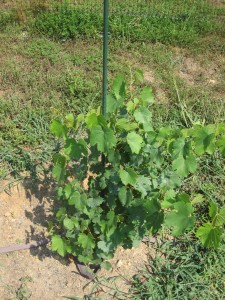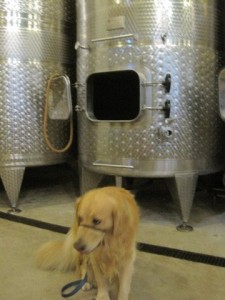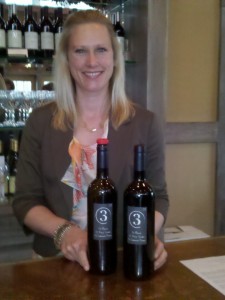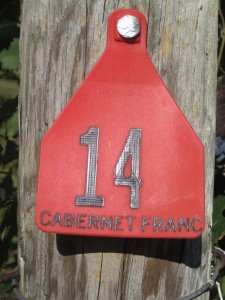We’ve learned a lot about viticulture (so much so that if we were in the army, the body of knowledge we’ve accumulated would fall under the heading of “knowing just enough to get us killed”), and so we’re feeling like we want to plant a larger vineyard this Spring. “Larger” is a relative term, of course; given that we’re starting with a vineyard of seven vines, it would be hard to go smaller. We’re thinking of something between 100 and 200 vines.

- Our Nelson County vines are feeling lonely – hopefully this Spring we’ll give them some company.
Most people in the business, even most backyard vintners, would regard that as a small undertaking, but it’s large for us, especially since we won’t be living close to this vineyard for at least the next few years. Everything we plant has to be maintained, and that includes spraying very soon (within 24 hours) after any rainfall that drops more than three-quarters of an inch of water onto the vines. So, while the number of vines we’re considering is very small by most standards, it’s sizeable by the criteria most relevant to us.
However, it makes the question of what grapes to plant – and how many different types of grapes to plant – much more complicated.
In a small vineyard like ours, it’s probably best to plant relatively few types of grapes, since it’s easier to process 50 gallons of one type of wine that 25 gallons each of two varieties. Well, we’re going for fun, not efficiency, so we’re thinking of four or five, all in the Vitis vinifera family of European-style grapes. There are others, such as Norton, a Virginia original, that are much easier to grow (less spraying, less worry all around), and many Virginia wineries say that Norton is their most popular grape. But again, we intend for this to be a labor of love, so while we’re not going to disregard entirely issues of suitability, we’ve decided to grow varietals that we love.
First off, we want a white, and Viognier has been named Virginia’s signature grape by the Virginia Wine Board. We wouldn’t agree that Viognier is the best grape, period, for Virginia, but among whites, we do think a Virginia Viognier is something quite special. Chardonnay and other whites do well here, but I think Viognier grown in Virginia has the potential to be world class. So, Viognier makes the cut – three (or maybe four) to go.
Next, we’d like to have some kind of desert wine, and after drinking a bottle of Petit Manseng from Veritas Vineyards over the weekend, we decided to add that one as well to the shopping list. Two down, now on to the reds.
We like Bordeaux-style blends, so we want to choose from among the great grapes of Bordeaux: Cabernet Sauvignon, Merlot, Cab Franc and Petit Verdot. (I’m not counting Malbec, which I doubt will do well on our property.) We’ve had all four from Virginia wineries, so we know they’re at least realistic options.
Almost everyone agrees that Cab Franc does well in Virginia, and we’ve had good Cab Francs from many wineries. In addition, the dozen Cab Franc vines that we planted in our two separate “vineyards” seem to be doing quite well, despite the late planting. So Cab Franc seems like an easy choice. But the results we’ve observed from Cab Sauv and Merlot are a bit spottier.
We’ve had very good Merlots from King Family Vineyards, among other wineries, and we tasted a lovely Merlot at Barboursville Vineyards Saturday, full of fruit, and very drinkable. I’ve also had a few Cabs from Virginia wineries that I’ve enjoyed, including one at Barboursville last weekend, but on the whole, I have to say that I haven’t loved Virginia Cabs as much as I would have liked. It would be nice to have one of the two for Bordeaux blends, and while my heart is always with Cab Sauv, my head tells me that Merlot is the better choice for us. This is a tough one.
That brings me to Petit Verdot. Two years ago, I had never tasted Petit Verdot as a varietal, and I can recall being surprised the first time it was offered in a tasting room. I remember enjoying it, but thinking of it as a bit of a novelty. I had grown up believing that Petit Verdot was a blending grape that was used in small amounts to correct acidity in Bordeaux blends.
A few weeks ago, when we decided to give Petit Verdot serious consideration for our vineyard, we visited a couple of wineries that bottled this grape as a varietal. Both were sold out, which we thought was a good indicator of what wine-drinkers think of Virginia Petit Verdot.

Phoenix, the Vineyard Dog, inspecting BOW's tank room. Here he is walking away from a tank after discovering that it was empty.
Our major concerns at this point were all practical. Petit Verdot is a late-ripening grape, at least as late as Cab Sauv, which we think might be hard to grow, and that concerned us. On the way home from Nelson County Thursday, we stopped at Barrel Oak Winery (BOW), which is not only dog friendly (Phoenix the Vineyard Dog was traveling with us), but we thought it featured a Petit Verdot (PV for the rest of this post).
Alas, BOW was also sold out of PV. However, we lucked out. Sharon Roeder, who owns BOW along with husband Brian, and serves as its winemaker, took us on a tour of the winery, and offered a barrel sample of the 2010 PV.
It’s not so easy to tell how a wine will develop as it continues to age in the barrel, and then ages some more in the bottle. But I was just blown away by this Petit Verdot. It’s a big, bold, exuberant wine that is just full of fruit. I would have loved to have poured a bottle and taken it home. However, this wine has a ways to go before it’s bottled sometime in the Spring of 2012. Before bottle aging starts, it will have spent 15 months in oak. Fortunately, BOWs 2009 PV will be released in a couple of months. I expect to be first in line.
So, that tasting eliminated by doubts about growing Petit Verdot. Maybe it’s more difficult than other grapes, but the results are surely worth it. And while I agree that Viognier is Virginia’s signature white grape, I’m wondering if Petit Verdot will join Cab Frank as the Commonwealth’s (by my reckoning) signature red.
So, we’re done to Viognier, Petit Manseng, Cab Frank, Petit Verdot, and maybe Merlot. Now the real challenges begin. How much of the total vineyard to plant next Spring? How many of each varietal? And which nursery to buy the vines from? Tough questions. Probably best to ponder them over a glass of wine. Maybe a Virginia Viognier.
Like this:
Like Loading...







Recent Comments